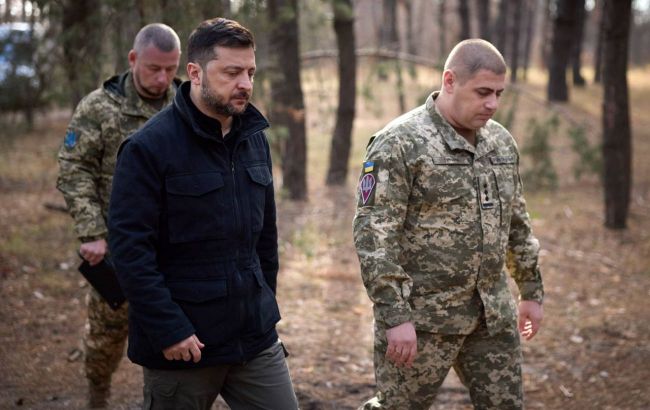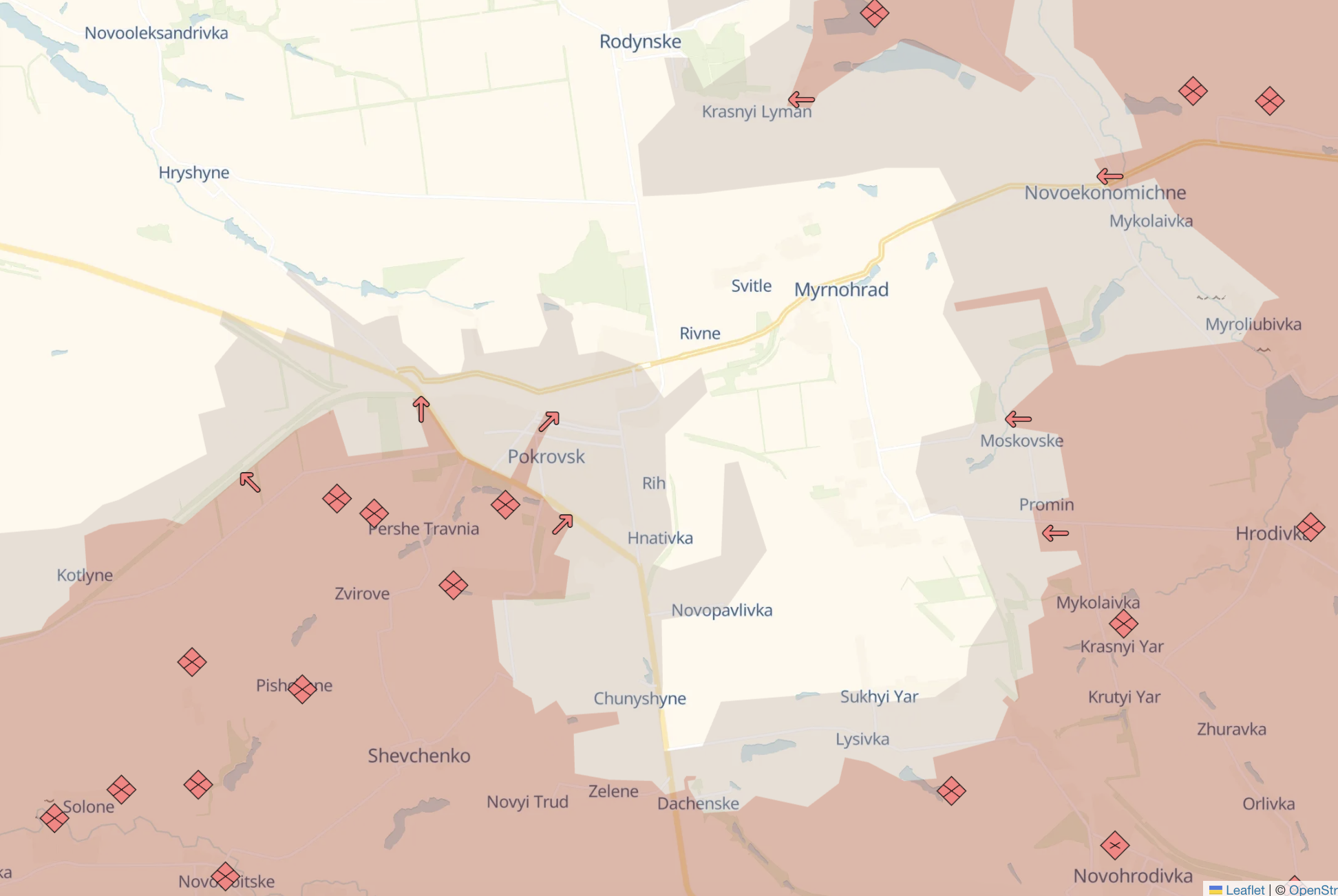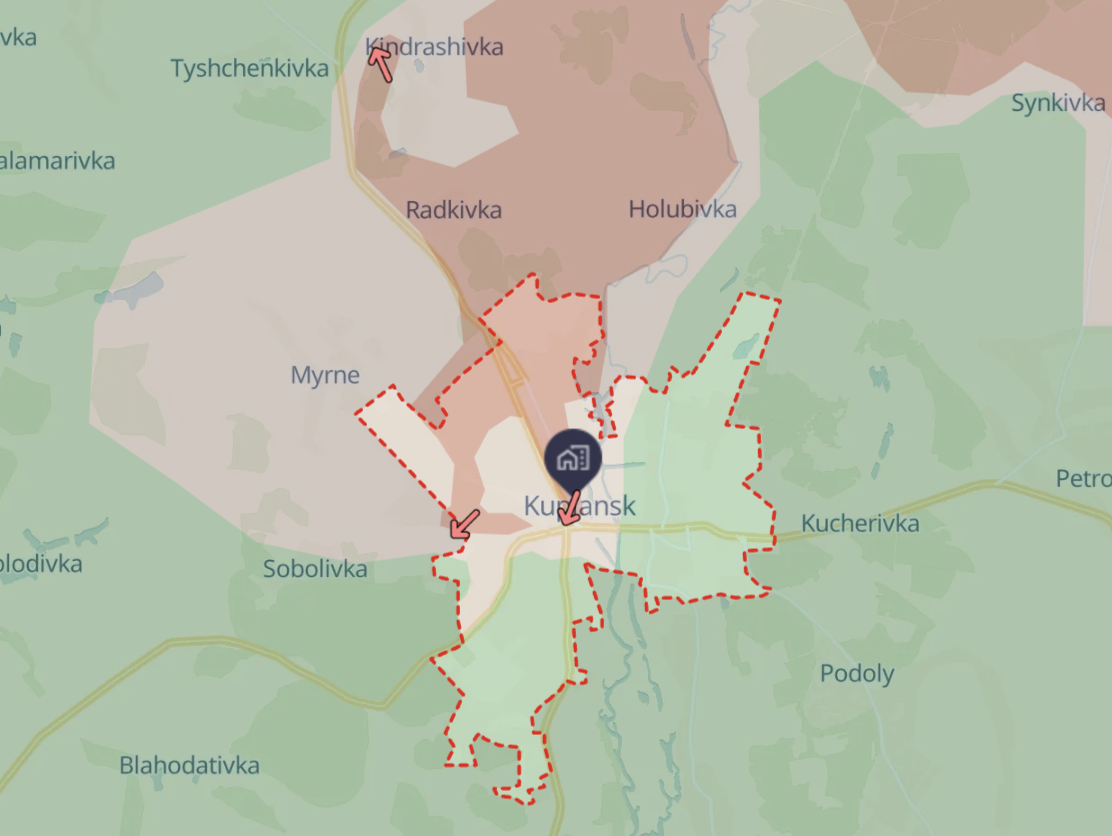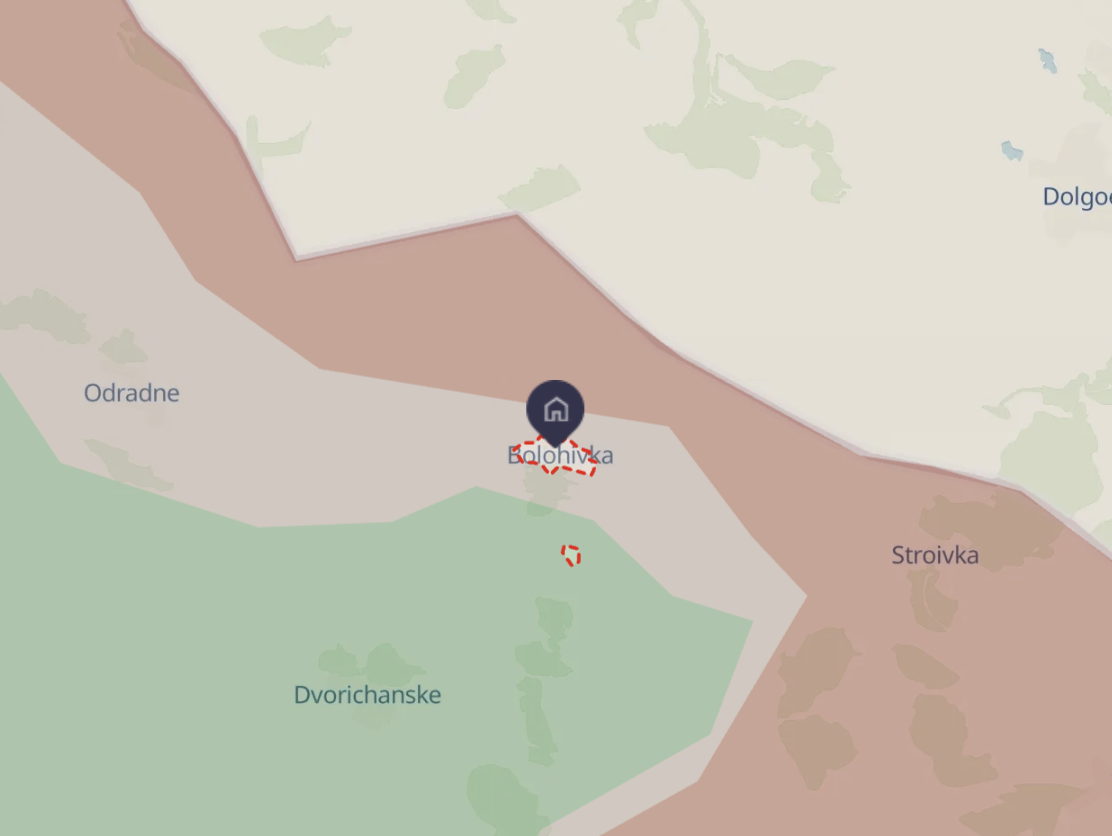Battle for Pokrovsk and Kupiansk: Can Ukraine's eastern front survive Russia's assault
 The Defense Forces are trying to hold Pokrovsk and Kupiansk (photo: Telegram channel of Volodymyr Zelenskyy)
The Defense Forces are trying to hold Pokrovsk and Kupiansk (photo: Telegram channel of Volodymyr Zelenskyy)
After statements about the alleged encirclement of Pokrovsk and Kupiansk, Russian forces are still engaged in fierce urban fighting there. RBC-Ukraine analyzes the chances of the Defense Forces holding these two cities and what Moscow’s plan is.
Key questions:
-
What does the situation around Pokrovsk and Myrnohrad really look like?
-
What are the chances of holding Pokrovsk and Kupiansk?
-
What is the situation in Kupiansk, and why is the enemy so determined to occupy this city?
Two weeks have passed since the leaders of the Russian army — Putin and Gerasimov (Chief of the General Staff) — claimed the alleged encirclement of Kupiansk and Pokrovsk. Active and intense fighting is still ongoing in these settlements. And although Moscow has already rushed to declare the battles for these two towns finished, their culmination is still ahead.
According to RBC-Ukraine, the Russian General Staff initially planned to occupy Kupiansk and Pokrovsk by the end of October. Now these deadlines have been postponed once again.
Pokrovsk
The epicenter of fighting in the Donetsk region is the Pokrovsk agglomeration. For several consecutive months, the enemy has been infiltrating small infantry groups in the area, identifying weak points in the city's defenses.
Initially, groups of 1–3 soldiers were slipping into Pokrovsk from the south, from the direction of Zvirove and Troyanda. About a month ago, infiltration by enemy groups began in another area of the west, from the Kotlyne area toward the industrial zone in the northwest of the city. Very recently, the enemy's advance into Pokrovsk has also been recorded from the southeast.
"Over the past few days, the Russians have intensified their efforts to penetrate Pokrovsk with light vehicles through the southern outskirts. For this, the enemy has used unfavorable weather conditions, particularly dense fog. This reduces the effectiveness of our aerial reconnaissance and engagement in open terrain. Currently, more than 300 Russians are in the city. Their goal remains unchanged — to reach the northern outskirts of Pokrovsk and then attempt to encircle the agglomeration," the 7th Air Assault Corps, which holds the defensive line in the Pokrovsk area, reported on November 11.
Taking advantage of the fog that has covered the city over the past three days, Russian infantry began advancing toward Pokrovsk along the E50 highway using buggies, cars, and motorcycles. According to one source, on November 9 alone, approximately a hundred enemy soldiers could have entered Pokrovsk. According to estimates shared by the military in conversations with the publication, between 300 and 500 Russian soldiers may currently be in Pokrovsk.

 Situation in the Pokrovsk agglomeration (maps: DeepState and BlackBird)
Situation in the Pokrovsk agglomeration (maps: DeepState and BlackBird)
"In Pokrovsk, our troops are literally mixed with the Russians. The fighting is mostly conducted with drones. In Myrnohrad, our guys are holding their positions. The Russians are not putting as much pressure directly on Myrnohrad — they understand it's easier for them to push through the flanks and complete the encirclement. Then they could take Myrnohrad without heavy fighting," one of RBC-Ukraine's sources said.
If one were to roughly describe the zones of control in Pokrovsk, according to several of the outlet's sources and some OSINT (open-source intelligence) analysts, they currently look approximately as follows: the southern and southwestern parts are under the control of Russian forces; the central area, around the railway, is a gray zone; and the northern part remains under the control of the Defense Forces.
In addition to the fighting inside the city and the pressure from the east toward Myrnohrad, the enemy is simultaneously advancing on the agglomeration from the north — from the area of Krasnyi Lyman and Rodynske — the same flank that hangs over Pokrovsk.
The enemy's plan is for units of the 2nd Combined Arms Army, which are advancing from the west of Pokrovsk, to "meet" with the 51st Army group moving from the direction of Krasnyi Lyman, near the settlement of Hryshyne. This would create an encirclement of the agglomeration.
So far, the Defense Forces have managed to disrupt these plans, holding back the enemy on both axes. Recently, Ukrainian troops carried out counteractions in Rodynske, which are expected to help secure the supply lines for the units defending Myrnohrad.
Despite some optimistic developments, the situation in this area remains highly challenging. According to RBC-Ukraine's sources in the Defense Forces, Moscow aims to capture Pokrovsk by December 15 — its latest deadline. Opinions among the outlet's interlocutors regarding the realism of these plans are quite divided.
"There is a severe shortage of personnel. Some soldiers from Myrnohrad are already out of contact. We could lose Pokrovsk before December," one officer said.
At the same time, another assessment suggests that the Defense Forces still have a chance to hold the agglomeration until the end of the year — provided no unexpected events occur, such as a battalion being withdrawn from its positions or the Russians sending in substantial reinforcements.
"The situation there is complicated, but it is being addressed. The President issued an order at the Staff meeting to stabilize the situation in Pokrovsk by November 10 and in Kupiansk by November 15. The instruction was to take measures to prevent further Russian advances or the encirclement of our troops. Accordingly, almost everyone available has been redeployed there. The Commander-in-Chief is personally overseeing the situation. So, for now, the question of withdrawal is not on the table. In Kupiansk, the situation looks more dangerous than in Pokrovsk, because all attention is currently focused on Pokrovsk," another informed source in the Defense Forces told RBC-Ukraine on condition of anonymity.
Kupiansk and Kharkiv region
In Kupiansk, the Russians are attempting to push into the city center from the north and west to reach the R07 road (Kupiansk–Chuhuiv), which has operational and tactical significance for the Ukrainian grouping on this front segment. The enemy's attack tactics in the city are nearly identical to those in the Pokrovsk agglomeration.

 Situation in Kupiansk (maps: DeepState and BlackBird)
Situation in Kupiansk (maps: DeepState and BlackBird)
According to estimates from several sources, RBC-Ukraine currently hears that there may be approximately 70 Russian service members in the city. Although they have been reported in northern, central, and even southern districts, various OSINT maps suggest that the Defense Forces control at least half of Kupiansk. Yesterday, the president stated that the situation in the city has improved, and this trend has been ongoing for several weeks.
"There is a certain number of Russian troops in the northern districts of Kupiansk and a certain number of Ukrainian troops in other districts. Both our forces and the enemy are attempting active operations to seize the city. The particularity of this place is that logistics to it are complicated for both sides — for the Russians and for us," Victor Tregubov, head of communications for the Joint Forces Group, told RBC-Ukraine.
He stated that fighting in Kupiansk is primarily conducted by small infantry groups, amid a large number of drones in the air and difficulties with resupply and even the delivery of certain munitions.
The fact is that Russian forces are currently attacking the city only from a small northern bridgehead on the right bank of the Oskil River. Thus, the supply of their group that entered Kupiansk is carried out via crossings and a pipeline located north of the city, on the left bank of the Oskil. The Defense Forces are actively targeting these lines to slow the enemy.
At the same time, the Russians are attempting to advance actively from the south toward Kupiansk–Vuzlovyi, where a Ukrainian bridgehead is located on the left bank of the Oskil. In addition, one of the supply routes for Ukrainian troops holding positions east of Kupiansk — on the left bank — passes through that settlement.
"They are trying to push the Ukrainians out of Kupiansk-Vuzlovyi so that the city of Kupiansk would effectively be left in a semi-encirclement. However, they have not succeeded at present. Therefore, for now, they are exerting pressure on the city primarily from the north," Tregubov explained.
To solve the logistics problem for its units that have pushed onto the right bank of the Oskil, the enemy seeks to expand its bridgehead there, advancing both from the Dvorichna direction and from the border. As early as the summer, the enemy entered the settlement of Milove from the Belgorod region. Recently, it has stretched this control zone eastward to Bologivka, connecting it with its positions along the border on the Kupiansk axis.
 Bolohivka on the map (map: DeepState)
Bolohivka on the map (map: DeepState)
"In fact, they tried to create along the border a so-called sanitary zone; it is not wide, a few kilometers. But they sought to enter Ukrainian territory directly, and they partially succeeded. However, there is no significant advance there. From a strategic perspective, it cannot be said that this is a major gain. Although it is unpleasant, and even more concerning is that they continue to try to press forward, specifically in the Velykoburluk direction. On the other hand, our military is also offering active resistance there," Tregubov said.
The enemy's goal and plan on the Kupiansk axis is to push Ukrainian units off the left bank of the Oskil, seize the Borova–Izium–Sviatohirsk–Lyman bridgehead, and thereby create an overhanging flank for an advance on Sloviansk. This is analogous to the plans the Russians developed in 2022.
 Part of the bridgehead that the Russians seek to capture (map: DeepState)
Part of the bridgehead that the Russians seek to capture (map: DeepState)
RBC-Ukraine's interlocutors state that the deadlines set by Moscow for the Russian army to carry out this plan are the end of 2025. Although the Russians will likely manage to advance somewhat in this sector over the next two months, capturing the entire area within the specified timeframe is not realistic.
The enemy's offensive on Pokrovsk is also part of this plan: if Russian forces capture the Pokrovsk agglomeration, they will also advance toward the Kramatorsk–Kostiantynivka agglomeration, but from the south.

